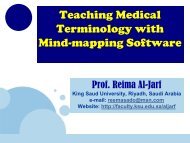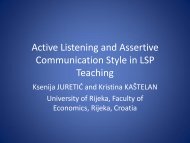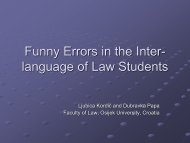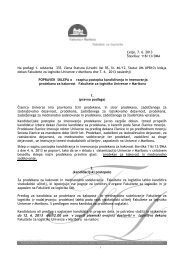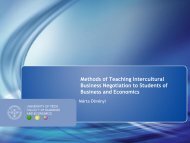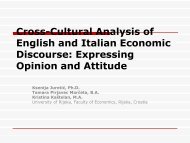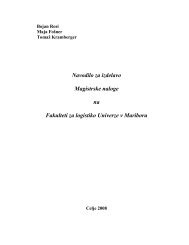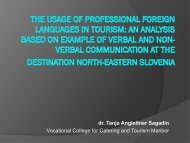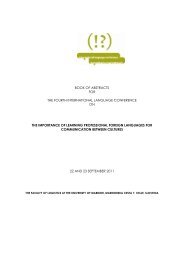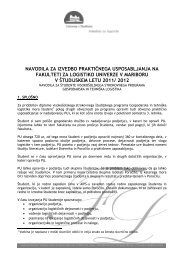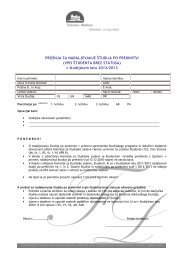A reading skill
A reading skill
A reading skill
Create successful ePaper yourself
Turn your PDF publications into a flip-book with our unique Google optimized e-Paper software.
Reading Skills and Reading<br />
Comprehension in English for<br />
Specific Purposes<br />
Mag. Phil. Milevica BOJOVIC<br />
University of Kragujevac, Faculty of Agronomy Cacak,<br />
Serbia<br />
23-24 September 2010, Celje
Reading activity<br />
complex, purposeful, interactive, comprehending,<br />
flexible, it develops gradually.<br />
Reading comprehension<br />
� main objective of <strong>reading</strong> process<br />
� purpose of <strong>reading</strong> activity<br />
� product of <strong>reading</strong> a text<br />
A <strong>reading</strong> <strong>skill</strong><br />
� a cognitive ability a person is able to use when interacting<br />
with the written text<br />
� task-oriented<br />
� deployed unconsciously
Taxonomies of <strong>reading</strong> <strong>skill</strong>s<br />
Davies (‘68) Munby (‘78)<br />
• identifying word meaning<br />
• drawing inferences<br />
• identifying writer’s technique<br />
• recognizing mood of passage<br />
• finding answers to questions<br />
• recognizing script of language<br />
• deducing meaning & use of familiar<br />
lexical items<br />
• understanding:<br />
-explicit & implicit information<br />
-conceptual meaning<br />
-communicative value of sentences<br />
-relations within sentence & between<br />
parts of text<br />
• recognizing: discourse indicators &<br />
main information<br />
• basic reference <strong>skill</strong>s<br />
• skimming & scanning
Taxonomies of <strong>reading</strong> <strong>skill</strong>s<br />
Lunzer et al. (‘79) Grabe (‘91)<br />
• word meaning in context<br />
• literal comprehension<br />
• drawing inferences<br />
• interpretation of metaphor<br />
• finding main ideas<br />
• forming judgments<br />
• automatic recognition <strong>skill</strong>s<br />
• vocabulary & structural<br />
knowledge<br />
• formal discourse structure<br />
knowledge<br />
• content/word background<br />
knowledge<br />
• synthesis & evaluation <strong>skill</strong>s<br />
• metacognitive knowledge &<br />
<strong>skill</strong>s monitoring
Possible criteria for ranking <strong>skill</strong>s<br />
� logical implication – one component to be<br />
considered to presuppose all components<br />
below;<br />
� pragmatic implication – reader displaying<br />
one <strong>skill</strong> can be assumed to possess all lower<br />
<strong>skill</strong>s;<br />
� difficulty – components arranged in order of<br />
increasing difficulty;<br />
� developmental – some <strong>skill</strong>s are required<br />
earlier than others.
Reading <strong>skill</strong>s in English for Specific Purposes<br />
Two contributions to the approach to <strong>reading</strong> in ESP<br />
are of prime importance (Dudley-Evans & St John,<br />
1998):<br />
1. the shift from text as a linguistic object to text as a<br />
vehicle of information (Johns & Davies, 1983),<br />
and<br />
2. the recognition that good <strong>reading</strong> requires<br />
language and <strong>skill</strong>s.
text as a linguistic object vs. text as a source of information<br />
� text of general topics, modified,<br />
selected by teachers, controlled<br />
new vocabulary;<br />
� no preparatory activities;<br />
� focus on language (all words<br />
/sentence understanding);<br />
� teacher-centered;<br />
� comprehension questions,<br />
grammar & lexis exercises.<br />
� texts according to students’<br />
needs, authentic, graded through<br />
tasks & support;<br />
� preparatory activities to awaken<br />
interest, to establish purpose;<br />
� focus on information, links<br />
between functions and form,<br />
guessing unknown words;<br />
� learner-centered;<br />
� information transfer application,<br />
applying versatile techniques.
the <strong>reading</strong> component of an ESP course<br />
requires balance between two elements:
successful L2 learners go for<br />
overall meaning, guessing or<br />
skipping language and<br />
information<br />
less successful L2 learners have<br />
fragmented approach to text
Roles of language and <strong>skill</strong>s<br />
� poor <strong>reading</strong> in a L2 is due in part to poor<br />
<strong>reading</strong> in L1, together with an inadequate<br />
knowledge of L2;<br />
� the learners need to reach a threshold level of<br />
L2 before they are able to transfer any L1<br />
<strong>skill</strong>s to their L2 <strong>reading</strong> tasks.
Crucial <strong>skill</strong>s to be learnt or transferred into<br />
the new language (Dudley-Evans & St John,<br />
1998):
Classroom <strong>reading</strong> procedures<br />
Pre-<strong>reading</strong> While-<strong>reading</strong> Post-<strong>reading</strong><br />
� predicting<br />
� word association<br />
� discussions<br />
� text surveys<br />
� list of questions<br />
� scanning &<br />
skimming<br />
� work out meaning<br />
of unfamiliar words<br />
� pattern study guides<br />
� summarizing<br />
� clarifying<br />
� questioning<br />
� review of the content<br />
� work on grammar<br />
� vocabulary in context<br />
/word roots<br />
� writing assignment<br />
� discussions<br />
� debates<br />
� role-plays<br />
� project work
� cloze test<br />
� gap-filling test<br />
Reading testing techniques<br />
Formal Informal<br />
� multiple-choice techniques<br />
� matching<br />
� ordering tasks<br />
� editing tests<br />
� integrated approaches (cloze<br />
elide test, short-answer test, freerecall<br />
test, summary test)<br />
� information-transfer techniques<br />
(tables, diagrams, flow-charts,<br />
maps)<br />
� interviewing readers about their<br />
habits, problems<br />
� self-report techniques (thinkalouds,<br />
diaries, reader report)<br />
� cloze technique<br />
These techniques – more<br />
appropriate in assessing extensive<br />
<strong>reading</strong>.
Research objectives and methods<br />
The research objective – improvement of <strong>reading</strong><br />
comprehension in English as a second language –<br />
ESP (English in Agronomy, Food Technology and<br />
Agroeconomy);<br />
Organization of research: November 2007 – June<br />
2009, Faculty of Agronomy in Cacak, Serbia;<br />
The participants – undergraduate students – total<br />
number 93 (seniors, juniors, sophomores and<br />
freshmen);
Assumptions<br />
� intensive <strong>reading</strong> training and testing<br />
frequency, applied separately, can improve<br />
<strong>reading</strong> <strong>skill</strong>s in L2;<br />
� change of the nature of the text used in testing<br />
does not affect achievements in <strong>reading</strong><br />
comprehension tasks.
Research instruments<br />
� authentic English passages – English for Specific<br />
Purposes (ESP) or General Purpose English (GPE);<br />
� <strong>reading</strong> comprehension tests (multiple choice,<br />
true/false technique, cloze test, filling gaps, matching,<br />
information transfer techniques – completing<br />
diagrams/tables/flowcharts with the required<br />
information);<br />
Reading comprehension questions focused on text<br />
meaning.
Variables & results: Group I on initial and<br />
final ESP tests and GPE test<br />
Group I<br />
(Agroeconomy)<br />
highly<br />
intensive<br />
training<br />
in<br />
<strong>reading</strong><br />
<strong>skill</strong>s<br />
Seniors<br />
Juniors<br />
Nr<br />
of<br />
students<br />
5<br />
7<br />
Nr<br />
of<br />
beginners<br />
2<br />
0<br />
Studying<br />
English<br />
at<br />
Faculty<br />
(years)<br />
3<br />
2<br />
Period<br />
of<br />
<strong>reading</strong><br />
<strong>skill</strong><br />
training<br />
(years)<br />
1<br />
0<br />
Initial<br />
ESP<br />
test<br />
(% )<br />
51<br />
68.57<br />
Final<br />
(II)<br />
ESP<br />
test<br />
(%)<br />
67.27<br />
66.23<br />
GPE<br />
test<br />
(III)<br />
(%)<br />
68.5<br />
67.46
Variables & results: Group II & III on initial and<br />
final ESP tests and GPE test<br />
Groups<br />
II & III<br />
Group II sophomores –<br />
agronomy &<br />
agroeconomy –<br />
medium-intensity<br />
training in <strong>reading</strong><br />
Group III sophomores -<br />
food technology – with<br />
no specific <strong>reading</strong><br />
training<br />
Nr<br />
of<br />
students<br />
13<br />
11<br />
Nr<br />
of<br />
beginner<br />
-s<br />
0<br />
0<br />
Studying<br />
English<br />
at<br />
Faculty<br />
(years)<br />
1<br />
1<br />
Period<br />
of<br />
<strong>reading</strong><br />
<strong>skill</strong><br />
training<br />
(years)<br />
0<br />
0<br />
Initial<br />
ESP<br />
test<br />
(%)<br />
33.60<br />
46.85<br />
Final<br />
(IV)<br />
ESP<br />
test<br />
(%)<br />
71.79<br />
60.61<br />
GPE<br />
test<br />
(V)<br />
(%)<br />
59.40<br />
59.60
Variables & results: Group IV on initial and<br />
final ESP tests and GPE test<br />
Group IV –<br />
elementary level<br />
students,<br />
true/false<br />
beginners<br />
Sophomores –<br />
agronomy,<br />
agroeconomy,<br />
food technology –<br />
intensive <strong>reading</strong><br />
training<br />
Nr<br />
of<br />
students<br />
25<br />
Nr<br />
of<br />
true/false<br />
beginner<br />
-s<br />
3/22<br />
Studying<br />
English<br />
at<br />
Faculty<br />
(years)<br />
1<br />
Period<br />
of<br />
<strong>reading</strong><br />
<strong>skill</strong><br />
training<br />
(years)<br />
1<br />
Initial<br />
GPE<br />
test<br />
(%)<br />
43.11<br />
Final<br />
(II)<br />
ESP<br />
test<br />
(%)<br />
33.67
Variables & results: Group V on initial and<br />
final ESP tests and GPE test<br />
Group<br />
V<br />
Freshmen -<br />
with no<br />
specific<br />
<strong>reading</strong><br />
training<br />
Nr<br />
of<br />
students<br />
32<br />
Nr<br />
of<br />
beginners<br />
6<br />
Studying<br />
English<br />
at<br />
Faculty<br />
(years)<br />
0<br />
Period of<br />
<strong>reading</strong><br />
<strong>skill</strong><br />
training<br />
(years)<br />
0<br />
Initial<br />
ESP<br />
test<br />
(%)<br />
42.44<br />
Final<br />
(III)<br />
ESP<br />
test<br />
(%)<br />
42.88<br />
GPE<br />
test<br />
(IV)<br />
(%)<br />
49.31
Conclusions<br />
� separately applied intensive <strong>reading</strong> training and frequency<br />
of testing improve student’s <strong>reading</strong> <strong>skill</strong>s;<br />
� combination of <strong>reading</strong> <strong>skill</strong> training of medium intensity<br />
and high frequency of testing showed the best results<br />
(Group II); it can be efficient with the students with lower<br />
level of knowledge and achievement in English language<br />
tasks (Groups II);<br />
� shift from ESP to GPE texts did not influence student<br />
achievements at higher academic levels (Group I);<br />
� change of the nature of the text used in testing does not<br />
affect achievements in <strong>reading</strong> comprehension tasks, except<br />
with the students with inadequate level of general foreign<br />
language <strong>skill</strong>s (Groups II and IV) and at low levels of<br />
academic education (Group V).
Selected references:<br />
Alderson, J. C. (1984). Reading in a foreign language: a <strong>reading</strong> problem or a<br />
language problem? In Alderson, J. C. & Urquhart, A. H. (Eds.) Reading in a<br />
Foreign Language. London: Longman.<br />
Alderson, J. C. (2000). Assessing Reading, Cambridge: Cambridge University Press.<br />
Davies, F. B. (1968). Research in comprehension in <strong>reading</strong>. Reading Research<br />
Quarterly, 3, 499-545<br />
Dudley-Evans, T. & St John, M. J. (1998). Developments in ESP: a multidisciplinary<br />
approach. Cambridge: Cambridge University Press.<br />
Grabe, W. (1991). Current developments in second language <strong>reading</strong> research. TESOL<br />
Quarterly, 25, 375-406.<br />
Johns, T. F. & Davies, F. (1983). Text as a vehicle for information: the classroom use<br />
of written texts in teaching <strong>reading</strong> in a foreign language. Reading in a Foreign<br />
Language, 1, 1-19.<br />
Lunzer, E., & Gardner, K. (Eds.). (1979). The effective use of <strong>reading</strong>. London:<br />
Heinemann Educational.<br />
Munby, J. (1978). Communicative syllabus design. Cambridge: Cambridge University<br />
Press.<br />
Urquhart, A. H., & Weir, C. J. (1998). Reading in a second language: Process,<br />
product, and practice. London and New York: Longman.
Reading Skills and Reading<br />
Comprehension in English for<br />
Specific Purposes<br />
Mag. Phil. Milevica BOJOVIC,<br />
University of Kragujevac, Faculty of Agronomy Cacak<br />
Serbia<br />
23-24 September 2010, Celje



